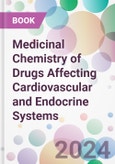Readership
PharmD / pharmacology students and teachers.Table of Contents
Chapter 1 Drugs Affecting Renin-Angiotensin System- M. O. Faruk Khan and Karrie Murphy
- Historical Background
- Introductory Concepts
- The Renin-Angiotensin System (Ras)
- Angiotensin-Converting Enzyme Inhibitors (Aceis)
- Structure of Ace Active Site and Mechanism of Ang I Hydrolysis
- Inhibition of Ace - the Acei-Ace Interaction
- Pharmacophore and Sar Summary of Aceis
- Sar Summary
- The Individual Aceis and Their Structural and Therapeutic Evaluations
- Sulfhydryl-Containing Inhibitor - Captopril
- Dicarboxylate Containing Inhibitors
- Phosphinate Containing Inhibitor - Fosinopril
- Angiotensin Ii Receptor Blockers (Arbs)
- The At1R Binding Pockets
- Pharmacophore of Arbs and Structure-Activity Relationship
- Sar Summary
- The Individual Arbs and Their Structural and Therapeutic Evaluations
- Recalls of the Arbs
- Therapeutic Considerations of Acei and Arbs
- Renin Inhibitor Aliskiren (Tekturna® )
- Case Study
- Drug Discovery Case Studies
- Discovery of Aceis
- Teprotide-The First Clue
- Carboxypeptidase a - the Homology Model
- Development of Captopril
- Development of Enalapril and Lisinopril
- Development of Arbs
- From Saralasin to Losartan and Eprosartan
- Student Self-Study Guide
- Student Self-Assessment Questions
- References
- Taufiq Rahman and M. O. Faruk Khan
- Historical Backgrounds of Ca 2+ - Channel Blockers
- Introductory Concepts
- The Voltage Gated Ca 2+ - Channels (Vgccs) and Their Clinical Significance
- Sub-Classes of Vgcc
- Calcium Channel Blockers
- The 1,4-Dihydropyridines (Dhps)
- Structure Activity Relationship (Sar) of Dhp Derivatives
- No-Releasing Activity of 1,4-Dihydropyridines
- Individual 1,4-Dihydropyridine Drugs
- Phenylalkylamines (Paas)
- Structure-Activity Relationship of the Phenylalkylamines
- Verapamil
- Benzothiazepines (Btzs)
- Structure-Activity Relationships of Benzothiazepines
- Diltiazem
- Diaminopropanol Ethers
- Clinical Case Studies
- Case
- Case
- Case
- Drug Discovery Case Studies
- Discovery of Verapamil
- Discovery of Nifedipine and Its Analogues
- Student Self-Study Guide
- Student Self-Study Questions
- Questions 6 - 8 Are Based on the Following Structures:
- References
- David J. Weldon, Krista G. Brooks and M. O. Faruk Khan
- Historical Perspectives
- Introductory Concepts
- Osmotic Diuretics
- Mechanism of Action of the Osmotic Diuretics
- Available Therapeutic Agents (Table 2)
- Carbonic Anhydrase Inhibitors
- Mechanism of Action of Cais
- Sar Summary of Sulfonamides as Cais
- Available Therapeutic Agents (Tables 3 and 4)
- Thiazide Diuretics
- Mechanism of Action of Thiazide Diuretics
- Sar Summary of Thiazide Diuretics
- Available Therapeutic Agents (Table 5)
- Loop Diuretics
- Mechanism of Action of Loop Diuretics
- Sar Summary of Loop Diuretics
- Available Therapeutic Agents
- Potassium-Sparing Diuretics
- Aldosterone Antagonists
- Available Agents
- Non-Steroidal Mra: Finerenone (Kerendia®)
- Epithelial Sodium Channel (Enac) Antagonists
- Available Agents (Table 8)
- Case Studies
- Drug Discovery Case Stories
- Discovery of Carbonic Anhydrase Inhibitor: Acetazolamide
- Discovery of the Thiazide Diuretic Chlorothiazide
- Discovery of Loop Diuretic Furosemide
- Student Self-Study Guide
- Student Self-Assessment Questions
- References
- C Hapter 4 Anticoagulants, Antiplatelets and Thrombolytic Agents
- M. O. Faruk Khan and A. R. M. Ruhul Amin
- Historical Background
- Introductory Concepts
- Hemostasis
- Biochemical Pathway of Clotting
- Blood Coagulation Risk Factors
- Anticoagulants
- Heparin and Derivatives
- Ufhs and Lmwhs
- Mechanism of Action
- Adverse Effects, Contraindications, Antidotes and Pharmacokinetics
- Fondaparinux (Arixtra®)
- Warfarin
- Chemistry, Mechanism of Action, and Therapeutic Uses
- Pharmacokinetics
- Monitoring of Warfarin Therapy
- Food and Drug Interactions
- Direct Thrombin Inhibitors (Dtis)
- Hirudin and Its Recombinant Derivatives
- Argatroban
- Oral Direct Thrombin Inhibitor: Dabigatran
- Direct Factor Xa Inhibitors
- Rivaroxaban (Xarelto®)
- Apixaban (Eliquis®)
- Edoxaban (Savaysa®)
- Betrixaban (Bevyxxa®)
- Antiplatelet Agents
- Cyclooxygenase Inhibitor: Aspirin
- Glycoprotein Iib/Iiia Receptor Blockers
- Abciximab (Reopro®)
- Eptifibatide (Integrilin®)
- Tirofiban (Aggrastat®)
- P2Y12 Receptor Blockers: Clopidogrel, Ticlopidine, Prasugrel, Ticagrelor
- Thienopyridine Derivatives
- Adp Analog: Cangrelor (Kengreal®)
- Cyclopentyltriazolopyrimidine: Ticagrelor
- Phosphodiesterase (Pde) Inhibitors
- Dipyridamole
- Cilostazol (Pletal®)
- Anagrelide (Xagrid®)
- Protease Activated Receptor 1 (Par-1) Antagonist
- Vorapaxar (Zontivity®)
- Thrombolytics
- Streptokinase
- Alteplase
- Reteplase (Retavase®)
- Tenecteplase (Tnkase®; Metalyse®; Elaxim®)
- Defibrotide (Defitelio®)
- Antidotes of Anticoagulants and Antiplatelets
- Protamine
- Andexanet Alfa (Andexxa®)
- Idarucizumab (Praxbind®)
- Vitamin K
- Platelet Stimulating Agents
- Thrombopoietin Receptor Agonists
- Eltrombopag (Promacta®)
- Romiplostim (Nplate®)
- Antifibrinolytic Agents
- Tranexamic Acid
- Ε-Aminocaproic Acid (Amicar®)
- Clinical Case Study
- Drug Discovery Case Study
- Discovery of Warfarin
- Discovery of Ticagrelor
- Discovery of Apixaban
- Student Self-Study Guide
- Student Self-Assessment Questions
- Match the Drug Structures (A-H) With the Appropriate Names (20-26).
- References
- C Hapter 5 Antihistamines, Proton Pump Inhibitors and Related Drugs
- M. O. Faruk Khan
- Historical Background
- Introductory Concepts
- Histamine Receptors
- Histamine Structural Considerations
- Histamine Agonists
- Receptor Structures and Pharmacophore Models of the H1 and H2 Receptors
- The Histamine H1 Receptor
- The Histamine H2 Receptor
- Histamine H1 Antagonists
- General Mechanism of Antihistaminic Action
- General Structure and Classification of Antihistamines
- Therapeutic Evaluations of Each Class of Antihistamines
- The General Structure Activity Relationship (Sar)
- The Aminoalkanes and Aminoalkenes (Propylamines)
- The Piperazines or Cyclizines
- The Piperidines
- The Aminoalkyl Ethers - Ethanolamines and Propanolamines
- Ethylenediamines
- Phenothiazines
- Miscellaneous Antihistamines
Author
- M. O. Faruk Khan








